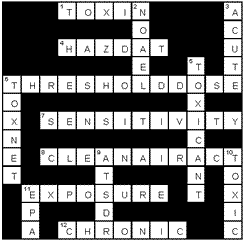Answer Key
On This Page
Module I – Test Your Knowledge Quiz Answers
- Which of these groups is usually designated as one of the most sensitive sub-populations for exposures to toxic substances?
- Adult women
- Infants
- Adult men
- Adolescents
- You have worked at a chemical facility for 10 years. The facility does not require protective equipment, and you have developed a number of serious health effects in the last 7 years. You are possibly experiencing what type of exposure?
- Chronic
- Acute
- You are worried about contamination of vegetables grown in contaminated soils. What type of toxicologist would you contact?
- Descriptive
- Environmental
- Regulatory
- Food
- You are concerned about the risks associated with growing vegetables in soil with naturally high lead and arsenic concentrations. You are speaking of what type of substance?
- Toxin
- Toxicant
- The larger the amount of exposure and the greater the dose, the greater the observed response, or effect.
- True
- False
- What type of toxicologist takes samples of blood, urine or hair for testing?
- Descriptive
- Analytical
- Mechanistic
- Forensic
- Toxic agents can be classified in terms of their physical state, their effects, and their source.
- True
- False
- Which agency deals with the health effects that may occur from environmental exposure to toxic chemicals?
- The Environmental Protection Agency
- The Centers for Disease Control and Prevention
- The Agency for Toxic Substances and Disease Registry
- The Nuclear Regulatory Commission
- Which database has information on emergency handling procedures, environmental data, regulatory status and human exposure?
- TOXNET
- HazDat
- IRIS
- MEDTREC
- HazDat contains information on hazardous substances found at NPL and non-NPL waste sites, and on emergency events.
- True
- False
- The no observed adverse effect level (NOAEL) is also known as the no effect level (NEL).
- True
- False
- The term toxicant is used when talking about toxic substances that are produced by or are a by-product of human-made activities.
- True
- False
Module I – Toxicology Puzzle Solution

Module II – Routes of Exposure Word Scramble and Matching Solution
Word Scramble
- skin
- intestine
- nose
- eye
- mouth
- ambient
- macrophages
- environment
- biological
- gaseous
- soil
- air
- water
- food
- dermis
- inhalation
- route
- media
- groundwater
- food chain
QUICK MATCHING
Match the routes of exposure with the correct way for the hazard to enter the body.
- Absorption
- Ingestion
- Inhalation
_A_ Skin
_A_ Eye
_B_ Mouth
_B_ Intestine
Module III – Risk Assessment Test Your Knowledge Quiz Answers
- Which of the following is NOT a step in the Risk Assessment Process?
- Hazard identification
- Hazard evaluation or dose-response assessment
- Exposure dose
- Risk characterization
- Epidemiology is the study of causative factors associated with the occurrence and number of cases of disease and illness in a specific population.
- True
- False
- Exposure tells the toxicologist what dose causes a “response” usually illness or death, in the test animal.
- True
- False
- What activities should be conducted during the hazard identification step of the risk assessment?
- Identifying the substance name
- Describing the physical/chemical properties of the toxic substances
- Identifying the sources of toxicity information
- Identifying the exposure pathway
- All of the above
- Prospective epidemiological studies gather information from the past.
- True
- False
- The exposure assessment step in the risk assessment process identifies all EXCEPT which of the following?
- Frequency of exposure
- Type of chemical exposure
- Length of time of exposure
- Route of exposure
- Calculation of the amount of exposure
- Susceptible populations that may be more at risk for illness than others includes the following EXCEPT:
- Young children
- Older adults
- Teenagers
- Women of Childbearing Age
Module IV – Survey of Toxic Substances Test Your Knowledge Quiz Answers
- What are some effects from arsenic exposure?Death, fever, anorexia, and liver enlargement are some of the effects listed in the module.
- What form of mercury is the most toxic?Methyl mercury is the most toxic form of mercury.
- List some solvents you may use in the home.Participant answers
- List the different classes of pesticides.Insecticides, Herbicides, Fungicides, Fumigants, Rodenticides
- How does carbon monoxide affect the body?Decreases amount of oxygen available to the body. Also causes headache, shortness of breath, nausea, irritability, increased respiration, chest pain, impaired judgement, and fainting.
- What are some sources of ozone?Lightning, high voltage electrical equipment, and air- and water-purifying devices are some sources of ozone.
- List the different outdoor air pollutants discussed in the Module.Carbon monoxide, Sulfur oxides, Ozone, Nitrogen oxides, Particulates